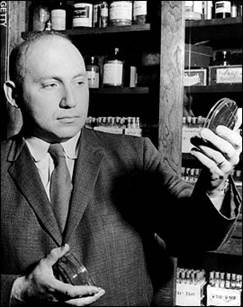Курсовая работа: Vectors for moleculars cloning
Sp6, T7 - promoters
Introduction
Cloning - is the process of creating an identical copy of something. In Biology, it collectively refers to processes used to create copies of DNA fragments (Molecular Cloning), cells (Cell Cloning), or organisms. The term also encompases situations, whereby organisms reproduce asexually, but in common parlance refers to intentionally created copies of organisms.
In 1972, Paul Berg and colleagues made the first “artificial” recombinant DNA molecule. The molecular analysis of DNA has been made possible by the cloning of DNA. The two molecules that are required for cloning are the DNA to be cloned and a cloning vector.
Cloning vector - a DNA molecule that carries foreign DNA into a host cell, replicates inside a bacterial (or yeast) cell and produces many copies of itself and the foreign DNA. Types of Cloning Vectors are Plasmid, Phage, Cosmids.
Molecular cloning refers to the process of making multiple molecules. Cloning is commonly used to amplify DNA fragments containing whole genes, but it can also be used to amplify any DNA sequence such as promoters, non-coding sequences and randomly fragmented DNA. It is used in a wide array of biological experiments and practical applications ranging from genetic fingerprinting to large scale protein production. Occasionally, the term cloning is misleadingly used to refer to the identification of the chromosomal location of a gene associated with a particular phenotype of interest, such as in positional cloning. In practice, localization of the gene to a chromosome or genomic region does not necessarily enable one to isolate or amplify the relevant genomic sequence. To amplify any DNA sequence in a living organism, that sequence must be linked to an origin of replication, which is a sequence of DNA capable of directing the propagation of itself and any linked sequence. However, a number of other features are needed and a variety of specialised cloning vectors (small piece of DNA into which a foreign DNA fragment can be inserted) exist that allow protein expression, tagging, single stranded RNA and DNA production and a host of other manipulations.
Cloning of any DNA fragment essentially involves four steps
· fragmentation - breaking apart a strand of DNA
· ligation - gluing together pieces of DNA in a desired sequence
· transfection - inserting the newly formed pieces of DNA into cells
· screening/selection - selecting out the cells that were successfully transfected with the new DNA
Recombinant DNA techniques have allowed the isolation and propagation of specific DNA fragments which can be easily sequenced and/or used as highly specific probes. In vitro site-directed modifications of these fragments and their reintroduction into the genome result in a modified genetic makeup of an organism. In addition, it is now possible to induce overproduction of commercially important proteins by genetically tailored microorganisms[8].
Several cloning strategies have been developed to meet various specific requirements. Cloning protocols have been designed for a variety of host systems. However, Escherichia coli still remains the most popular host of choice since its genetics, physiology, and molecular biology have been studied in great detail and a wealth of information is readily available. Many cloning vectors have also been constructed for use with E. coli as a host. Although this review focuses on the basic and applied aspects of bacteriophage lambda ectors, an overview of other vectors is included for comparison.
In general, cloning vectors can be broadly classified as plasmid and phage vectors.
So, the aim of this work is: to consider and study vectors of molecular cloning, and functions, properties etc.
Literature review
Plasmids are useful for a wide range of molecular genetic, genomic and proteomic approaches. In recent years, plasmid clone production has increased dramatically in response to the availability of genome information and new technologies.[9]
In 1952, Joshua Lederberg coined the term plasmid to describe any bacterial genetic element that exists in an extrachromosomal state for at least part of its replication cycle. As this description included bacterial viruses, the definition of what constitutes a plasmid was subsequently refined to describe exclusively or predominantly extrachromosomal genetic elements that replicate autonomously. [1]
Most plasmids possess a circular geometry , there are now many examples in a variety of bacteria of plasmids that are linear. As linear plasmids require specialized mechanisms to replicate their ends, which circular plasmids and chromosomes do not, linear plasmids tend to exist in bacteria that also have linear chromosomes [1]
Plasmids, like chromosomes, are replicated during the bacterial cell cycle so that the new cells can each be provided with at least one plasmid copy at cell division [1]
Frederick Twort (1915) and Felix d’Herelle (1917) were the first to recognize viruses which infect bacteria, which d'Herelle called bacteriophages (eaters of bacteria). [7]
Lambda (λ) bacteriophages are viruses that specifically infect bacteria. The genome of λ-phage is a double-stranded DNA molecule approx 50 kb in length. In bacterial cells, λ-phage employs one of two pathways of replication: lytic or lysogenic. [2]
In lytic growth, approx 100 new virions are synthesized and packaged before lysing the host cell, releasing the progeny phage to infect new hosts. In lysogeny, the phage genome undergoes recombination into the host chromosome, where it is replicated and inherited along with the host DNA. [2]
Cosmids - an extrachromosomal circular DNA molecule that combines features of plasmids and phage. [8]
Cosmids are conventional vectors that contain a small region of bacteriophage λ DNA containing the cohesive end site (cos). This contains all of the cis-acting elements for packaging of viral DNA into λ particles [4]
1. Plasmid Vectors
In 1952, Joshua Lederberg coined the term plasmid to describe any bacterial genetic element that exists in an extrachromosomal state for at least part of its replication cycle. As this description included bacterial viruses, the definition of what constitutes a plasmid was subsequently refined to describe exclusively or predominantly extrachromosomal genetic elements that replicate autonomously.
Figure 1. Joshua Lederberg
